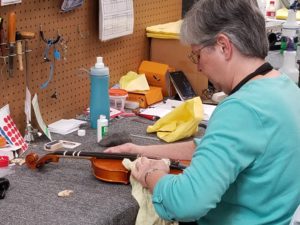Do you know what you need to keep your instrument clean and the musician in your life as safe as possible?
A crucial part of playing a musical instrument is keeping it properly maintained. The health and safety of everyone using a musical instrument should be a top priority. The possible transmission of communicable diseases is an ongoing concern. We recommend that all families take basic steps to clean their musical instruments to ensure this possibility is as low as possible. Below is information and links for what products you need to keep your musician safe.
Most viruses cannot live on hard surfaces for a prolonged period of time. However, certain groups are quite hardy. Therefore, musicians must be concerned with instrument hygiene. Playing an instrument that has never been cleaned or properly maintained can lead to higher instances of infection. If the cleaning process is thorough, musical instruments will be antiseptically clean. Just as the utensils you eat with, soap and water can clean off anything harmful, but must be used correctly so as not to damage an instrument. Antibacterial soaps will kill certain germs but all soaps will carry away the germs that stick to dirt and oils while they clean. No germs/ no threat. Be sure that students do not share instruments with family or friends.
The mouthpiece is an essential part of a wind instruments. As the only parts of these instruments placed either in or close to the musician’s mouth, research has concluded that these parts (and reeds) harbor the greatest quantities of bacteria. Adhering to the following procedures will ensure that these instrument parts will remain antiseptically clean for the health and safety of your child.
Cleaning the Flute Head Joint
- Carefully clean around the embouchure hole using a cotton swab saturated with denatured, isopropyl alcohol.
- Use alcohol wipes on the flute’s lip plate to kill germs.
- Clean the inside of the headjoint using a soft, lint-free cloth inserted into the cleaning rod.
- Do not run the headjoint under water as it may saturate and eventually shrink the headjoint cork.
Cleaning Clarinet/Saxophone Mouthpieces
- Swab mouthpiece after each playing and clean weekly.
- Select a small (to use less liquid) container that will accommodate the mouthpiece and place the mouthpiece tip down in the container.
- Fill the container to where the ligature would begin with a solution of half water and half white vinegar (50% water and 50% hydrogen peroxide works too). Protect clarinet mouthpiece corked tenons from moisture.
- After a short time, use an appropriately sized mouthpiece brush to remove any calcium deposits or other residue from inside and outside surfaces. Repeat this step if the mouthpiece is excessively dirty.
- Rinse the mouthpiece thoroughly and then saturate with Sterisol germicide solution. Place on paper towel and wait one minute.
- Wipe dry with paper towel.
- Note: Metal saxophone mouthpieces clean up well with hot water, mild dish soap (not dishwasher detergent), and a mouthpiece brush. Sterisol germicide solution is also safe for metal mouthpieces.
Cleaning Saxophone Necks (Crooks)
- Swabs are available to clean the inside of the saxophone neck. However, most saxophonists use a flexible bottle brush and toothbrush to accomplish the same results.
- Saxophone neck should be cleaned weekly (and swabbed out each day after playing).
- Use the bottlebrush and mild, soapy water to clean the inside of the neck.
- Rinse under running water.
- Sterisol germicide solution may be used on the inside of the neck at this time, if desired (not necessary). Place on paper towel for one minute.
- Rinse again under running water, dry, and place in the case.
Cleaning Brass Mouthpieces
- We recommend cleaning weekly.
- Clean the outside of the mouthpiece, using a cloth soaked in warm, soapy water.
- Use a mouthpiece brush and warm, soapy water to clean the inside.
- Rinse the mouthpiece and dry thoroughly.
- Sterisol germicide solution may be used on the mouthpiece at this time. After soaking in Sterisol, place on paper towel for one minute.
- Wipe dry with paper towel.
Strings and Percussion
- Most hygienic issues for string, percussion and keyboard instruments can be solved by the musician washing their hands before and after use.
- For string instruments, always wipe down your strings/fingerboard with a lint-free cloth to remove rosin from the strings. Do not use water or any chemicals as it can potentially damage the strings, fingerboard, and varnish of the instrument.
- Percussionists can wipe down the handle of sticks/mallets with an antiseptic wipe.
